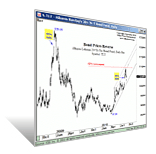Practice, Practice, Practice Makes Perfect Elliott Wave Analysis
InvestorEducation / Elliott Wave Theory Sep 17, 2016 - 11:07 AM GMTBy: EWI
 Tips on the best way to improve your wave-counting skills
Tips on the best way to improve your wave-counting skills
In this new interview with our Senior Instructor Jeffrey Kennedy, he tells you about the four key principles that'll help improve your Elliott wave skills.
See how sharp your wave counting skills are -- the more you practice, the better you'll become! Test Your Knowledge now with 11 practice charts!
* * * * * * *
[Editor's note: A text version of the interview is below.]
Alexandra Lienhard: I'm Alexandra Lienhard for ElliottWaveTV, and today I'm joined by Elliott Wave International's Jeffrey Kennedy, the editor of the popular Trader's Classroom, an educational service designed to help subscribers spot new trading opportunities for themselves using wave analysis and supporting technical indicators.
So Jeff, let's stick with the basics today. What's the best way to learn Elliott wave analysis and improve your wave-counting skills?
Jeffrey Kennedy: Hello, Alex. Well, really the best way that I've found to get good at counting Elliott waves is -- first, you need to know the five core foundational Elliott wave patterns. That would be the impulse wave, the diagonal, the zigzag, the flat and the triangle. And then, the second way is really practice, practice, practice. Pick up some price charts. Start trying to identify waves. Label the price charts. And then, see what actually happens.
One recommendation specifically that might be helpful to listeners is star t with the shorter-term time frame, maybe a 15-minute or a 30-minute price chart of the S&P, or gold, or the euro. On the shorter-term time frames, you can label the patterns and then typically within a day or two, you can see the resolution of what actually happens. So if you're identifying a zigzag on a 15-minute price chart, you only have to wait 2 or 3 hours to see if that identification is indeed correct.
Alexandra: You've mentioned before that you have a couple key points that help improve wave counting. Can you take me through those points and explain what you mean by each of them?
Jeffrey: Absolutely. There are really four things that I would recommend listeners embrace. Whenever you're labeling price charts, the things that help keep me between the lines are four key components. Number one: substructure. Number two: personality. Number three: proportion. And number four, of course, always strive to keep it simple. Now let me explain.
Whenever you're labeling a wave pattern, real-time, real-market, it's very important to make sure that the substructure is indeed there. For example, a zigzag is referred to as a 5-3-5 pattern. That means that wave A subdivides into 5 waves, wave B subdivides into 3 waves and wave C subdivides into 5 waves. So you need to make sure that those components, that substructure, are indeed there.
Two: personality. And what I mean by personality is, for example, if you're labeling a price move as a wave 3 -- well, that move should be very volatile, should be very sharp, either to the upside or to the downside, because in a third-wave price move, that's where prices travel very, very far in a very short period of time.
The third component, proportion. Make sure your waves are indeed proportional. It is very unlikely that you're going to have, say, a fourth wave countertrend move that lasted forty price bars -- and pair that with a second wave, or corresponding of the same degree second wave, that lasted only two price bars. Make sure that you adhere to R.N. Elliott's guideline of the "right look."
And finally, keep it simple. That's a big area where I see new Elliotticians or beginners make mistakes. They tend to begin, or lead, with very exotic interpretations -- for example, leading diagonals or expanding triangles. Always strive to keep it simple. Because if you keep it simple, the odds are you're going to be on the right path.
Alexandra: Well, keeping it simple is a good mantra to apply to things, not just in trading, but perhaps in all aspects of life! Now Jeff, with our last question today I wanted to do something a little bit different. Elliott Wave International has a popular report that allows readers to test their own knowledge of the Wave Principle. So I thought it would be fun to pull an example from that report and have you take us through what pattern is unfolding on the chart.
I've got a chart up on the screen right now, and for anyone watching, now might be a good time to pause the video and try testing your own knowledge by labeling the move from top to bottom. In the meantime, Jeff, I was hoping you could take us through your analysis and explain which of the five basic Elliott wave patterns is unfolding on this chart?
Jeffrey: Well, typically whenever I'm teaching, whether it's in a classroom or seminar or webinar, I always like to walk people through my thought process. And we can do the same thing with this price chart that you're showing now.
First of all, what are the five core foundational patterns, which we've already discussed? The impulse wave, the diagonal, the zigzag, the flat, and the triangle. Now, the next step is really the process of elimination. Does the move look like an impulse wave? Does it look like a diagonal? A zigzag? A flat? Possibly a triangle? Well, if you go through the process of elimination, you can pretty much, looking at the chart pattern as I see it, you can go ahead and scratch off impulsive wave, diagonal, and also the flat. The reason why the flat needs to go is because wave B of a flat should retrace at least 90% of wave A. That's in the book. [The Elliott Wave Principle by Frost & Prechter -- Ed.] Now, in the futures markets, you may actually be able to expand that parameter, say an 80% retracement of wave A, but the key characteristic of a flat correction is that wave B ends at or near the origin of wave A. And, of course, it's not a contracting triangle because you do not see converging trend lines.
So, through the process of elimination, that leaves us with one pattern remaining: the zigzag, the 5-3-5 pattern. And we can actually see some confirmation in the price chart by simply understanding the very key characteristic of zigzags: They tend to be contained within parallel lines, because one of the most common relationships between wave C and wave A is equality. So, the pattern we're looking at on the chart is a zigzag.
Alexandra: Jeff, in keeping it simple, you make it seem so easy! Thanks for talking today.
Jeffrey: My pleasure, Alex. Any time.
|
Test Your Wave Counting Skills It doesn't matter if you're a novice or experienced Elliottician, the more you practice the better you'll become at identifying waves. Take the challenge and test your wave counting skills on the charts in this free resource. |
This article was syndicated by Elliott Wave International and was originally published under the headline Practice, Practice, Practice Makes Perfect Elliott Wave Analysis. EWI is the world's largest market forecasting firm. Its staff of full-time analysts led by Chartered Market Technician Robert Prechter provides 24-hour-a-day market analysis to institutional and private investors around the world.
About the Publisher, Elliott Wave International
Founded in 1979 by Robert R. Prechter Jr., Elliott Wave International (EWI) is the world's largest market forecasting firm. Its staff of full-time analysts provides 24-hour-a-day market analysis to institutional and private investors around the world.
© 2005-2022 http://www.MarketOracle.co.uk - The Market Oracle is a FREE Daily Financial Markets Analysis & Forecasting online publication.





